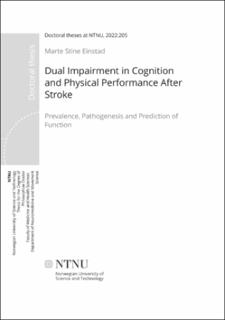| dc.contributor.advisor | Thingstad, Pernille | |
| dc.contributor.advisor | Saltvedt, Ingvild | |
| dc.contributor.author | Einstad, Marte Stine | |
| dc.date.accessioned | 2022-06-23T07:42:15Z | |
| dc.date.available | 2022-06-23T07:42:15Z | |
| dc.date.issued | 2022 | |
| dc.identifier.isbn | 978-82-326-6638-6 | |
| dc.identifier.issn | 2703-8084 | |
| dc.identifier.uri | https://hdl.handle.net/11250/3000177 | |
| dc.description.abstract | Dual impairment of physical performance and cognition has been reported to increase the risk of dementia, falls, and functional dependency. However, this coexistence of impairments has to a little extent been explored in stroke populations; instead, these impairments have been studied, diagnosed, and treated as distinct entities. As a result, further knowledge is needed to delineate the underlying pathological mechanisms of dual impairment and their consequences for long-term function in stroke survivors.
The overall aim of this thesis was to investigate both the synergistic relationship between physical performance and cognition after stroke and the associations between functional outcomes and brain pathology. This thesis was based on data from baseline and 3- and 18-month follow-ups of the Norwegian Cognitive Impairment After Stroke (Nor-COAST) study, a prospective multicenter cohort study including 815 participants admitted to stroke units with acute stroke in five Norwegian hospitals between May 2015 and March 2017.
Performance-based assessments included the Montreal Cognitive Assessment (MoCA) and Short Physical Performance Battery (SPPB) at baseline and 3-month follow-up. In addition, executive function, memory, grip strength, and dual task cost were assessed at 3-month follow-up. Instrumental activities of daily living (IADL) were assessed at 3-and 18-month follow-up with the Nottingham Extended ADL (NEADL) questionnaire. Approximately half of the Nor-COAST participants were included in an MRI sub-study in which information was obtained on markers of cerebrovascular and neurodegenerative pathology, as well as on stroke lesion location and volume.
Results from Paper 1 showed that every third participant in our sample showed impairment in either cognitive or physical function at 3 months post-stroke, with rates of concurrent impairment ranging from 10% to 23%, depending on which combination of assessments was applied. Impairments in physical performance and grip strength were associated with impaired global cognition, executive dysfunction, and impaired memory. Higher dual-task cost was only associated with executive dysfunction.
In Paper 2, combining measures of physical performance and cognition was found to be superior to assessing one domain exclusively in the prediction of change in IADL from 3 to 18 months post-stroke; however, cognition appeared to be a stronger predictor than physical performance when applied in combination within the same model. Overall, a stable level of IADL function was found among participants, but high scores on measures of both physical performance and cognition at 3 months post-stroke were associated with a statistically significant improvement in function over the ensuing 15 months.
Results from Paper 3 showed that a larger stroke lesion volume was associated with dual impairment in cognition and physical performance at the time of stroke. Pre-existing pathology was found in two-thirds of the participants; however, associations with dual impairment were not significant when adjusting for age, whereas the association with stroke lesion volume remained significant. Participants with dual impairment were older, had poorer pre-stroke function, and suffered more severe stroke, on average, than participants with only one or no impaired domain.
To summarize, this thesis found that impairments in cognition and physical performance are observed in a substantial number of stroke patients, and that performance-based testing of dual impairment at 3 months post-stroke is useful for predicting IADL function at 18 months. These results contribute to increased knowledge of the interplay between post-stroke cognition and physical performance, their associations with brain pathology at the time of stroke, and their role in the prediction of long-term function. The
identification of dual impairments at 3 months post-stroke may be relevant for preventing functional decline and supports the adoption of a holistic treatment approach for this patient group. Further research is needed to refine the methods for identifying risk profiles and developing personalized rehabilitation that targets especially vulnerable populations following stroke. | en_US |
| dc.language.iso | eng | en_US |
| dc.publisher | NTNU | en_US |
| dc.relation.ispartofseries | Doctoral theses at NTNU;2022:205 | |
| dc.relation.haspart | Paper 1: Paper 1 Einstad, MS; Saltvedt, I; Lydersen, S; Ursin, MH; Munthe-Kaas, R; Ihle-Hansen, H; Knapskog, AB; Askim, T; Beyer, MK; Næss, H, Seljeseth, YM; Ellekjær, H; Thingstad, P. Associations between post-stroke motor and cognitive function: a cross-sectional study. BMC Geriatrics. 2021;21(1):103. https://doi.org/10.1186/s12877-021-02055-7 This article is licensed under a Creative Commons Attribution 4.0 International License (CC BY 4.0) | en_US |
| dc.relation.haspart | Paper 2 Einstad, MS; Thingstad, P; Lydersen, S; Gunnes, M; Saltvedt, I; Askim, T. Physical performance and cognition as predictors of instrumental activities of daily living after stroke: a prospective multicenter cohort study. Accepted for publication in Archives of Physical Medicine and Rehabilitation, 2022. | en_US |
| dc.relation.haspart | Paper 3 Einstad, MS; Schellhorn, T; Thingstad, P; Lydersen, S; Aamodt, EB; Beyer, MK; Saltvedt, I; Askim, T. Neuroimaging markers of dual impairment in cognition and physical performance following stroke: The Nor-COAST study. | en_US |
| dc.title | Dual Impairment in Cognition and Physical Performance After Stroke: Prevalence, Pathogenesis and Prediction of Function | en_US |
| dc.type | Doctoral thesis | en_US |
| dc.subject.nsi | VDP::Medical disciplines: 700::Health sciences: 800 | en_US |

